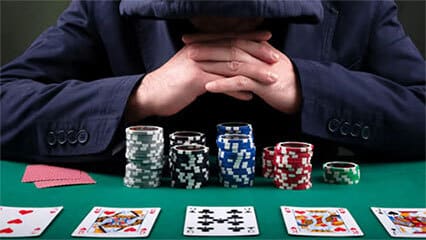Once you have played poker long enough, particularly at micro or low buy-in stakes, you will come across a player who, for whatever reason, wants to try and bluff at every other pot. We call this type of player a ‘maniac’ or ‘aggro fish.’
To be able to properly defend against this type of player and to be able to effectively play back at them, it is essential to understand what our opponent is doing and how they think. What kind of maniac are we dealing with? Just how many hands is he playing? Is she usually flatting when someone puts in a raise, or is he more aggressive with a lot of 3-bets? Does she prefer to do so more when in position or does the aggression come from anywhere? To succeed, you will need to pay close attention to how the opponent bets, both pre- and post-flop. Does the betting always continue on the turn and river? Most ‘maniacs’ will consistently follow through on all their bluffs, but some will just bet the flop and turn before giving up. Does the ‘maniac’ regularly bluff against multiple opponents or only when in a heads-up situation? Are they willing to put in a big check raise on the river as a bluff? We need to carefully observe any showdown in which they are involved and make a note of the action. If they muck after getting called by a weak hand, we will know they were bluffing. We may discover he loves to bluff on dynamic runouts – flushes and 4-card straights on the board – or he might overplay his value hands. Any information we can gather on the ‘maniac’ is valuable. We must practice constant vigilance to be effective against them in future hands.

What is a ‘Maniac’
There are many different types of ‘maniacs’ you will find at a poker table, and while it would be wonderful to look at each one individually, we will have to do that some other time. Here, we offer an overview of how best to handle the situation when a ‘maniac’ is at your table. One of the first things you need to know is the difference between a true ‘maniac’ and a player who is simply ‘on tilt.’
A poker maniac will have statistics (a player’s statistics can be found by mousing over their avatar in the GGPoker client) that look something like this:
VPIP: 55 PFR: 37 AF: 5
This means that this player is playing 55% of their hands. They are also raising an astonishingly high 37% of their hands. This player is playing an extremely aggressive style, which is even more insane considering how many terrible hands he plays.
Compare this to a regular tilted poker player:
VPIP: 55 PFR: 7 AF: 1
The ‘Maniac’ 3-Bet
It can be extremely frustrating when a ‘maniac’ is constantly 3-betting. Many people will adjust by 4-bet bluffing with an extensive range, but is this the correct counter-strategy? Remember, the ‘maniac’ never wants to give up, ever. While some ‘maniacs’ will fold under pressure, many are willing to call the 4-bet and try to outplay/out bluff us post-flop, while others will put in a 5-bet jam. We will also find ourselves in a large number of massive pots with weak holdings by taking this approach. A better strategy is to call a wider variety of hands to the 3-bet. It’s that simple. When he is 3-betting a wider range, we need less equity for a profitable call. We will also have high implied odds with our range when we hit the flop because he will often blast off with bluffs. We leave our 4-betting range to very strong hands but can widen it for value since we know he will continue with many weak hands. We can also tighten our preflop opening range to reduce the number of hands we raise-fold. This is an excellent strategy when the ‘maniac’ has position on us. Even minor adjustments can reduce our losses, such as folding some of the hands near the bottom of our opening range. You can also take some of the more marginal hands with good implied odds or playability – 6-6 or 7-8s, for example – and limp with them, planning to call his raise. This will keep the pot smaller and allow us to see a flop more often.
The same concepts we use pro-flop can be applied to post-flop as well. Trying to out-bluff a bluffer is a dangerous and costly game. These players revel in making the big hero calls and putting in the last bluff. This is not a game we will win or one we want to try to win. A better strategy is to let them go crazy with the bluff while we stick with a solid system. The ‘maniac’ will have an extensive range in most spots, so we can put in the occasional small bluff but try to stay with a more value-oriented approach. Let the game come to us, and don’t back down under pressure.

When the ‘Maniac’ does not Raise
When the ‘maniac’ does not raise and plays a more ‘traditional’ style, it is likely he has a strong starting hand. Of course, there are exceptions to every rule, but typically this tends to be a good indication you should muck your hand – unless your starting hand is also among the very best. The ‘maniac’ could attempt a multi-player trap by check-raising, which will benefit you if the flop improves your hand.
Different Types of Maniacs:
True manic Action junkie Wild/drunk player Steamer
Bulldozer One-street maniac Shark in disguise
No Hero Folds
We cannot call the flop and turn with a decent hand only to fold the river against these players. That’s just burning money. Instead, if we use the information about his range and tendencies, combined with the fact that we gave him the rope to keep bluffing wide, we have what we need to start picking off his stack. When a player consistently bets over multiple streets and plays an extensive preflop range, he will show up on the river with a ton of air. It’s impossible for him not to. Even if he bets full pot, we only need to beat about 33% of his range. We must take advantage of this and significantly widen our call range against this player type. Yes, we will end up in more large pots with marginal holdings (and losing some of them, which can make us feel uncomfortable), but if we’re looking to attain the highest win rate versus the ‘maniacs,’ we will have to get used to it. So buckle up and get ready to play some wild poker. If we are unwilling to make this adjustment or are uncomfortable with the strategy, the best action is to get up, leave the game, and look for a better table. Alternatively, we could play extremely tight pre- and post-flop, but there are more profitable approaches. The ‘maniac’ may end up walking all over us the entire night. There’s also the possibility that the stakes you are playing are too high.

Final Thoughts
A maniac sitting down will upset the whole dynamic of the table. The first player to figure it out will be the one who stands to profit the most. It can be a great opportunity, representing a big jump in expectation for you, but to take advantage, you need to make the proper adjustments. Ensure you are prepared so when it happens again, you finish on the positive side while your opponents grumble, wondering what happened.
Remember, the ‘maniac’ only has 2 cards like everyone else at the table. As we make the necessary adjustments and realize he is exploitable, our confidence will grow, and we will no longer feel uneasy whenever he is at the table.
And sometimes, it’s best to avoid playing at tables with a ‘maniac.’
Until next time, good luck at the tables!

